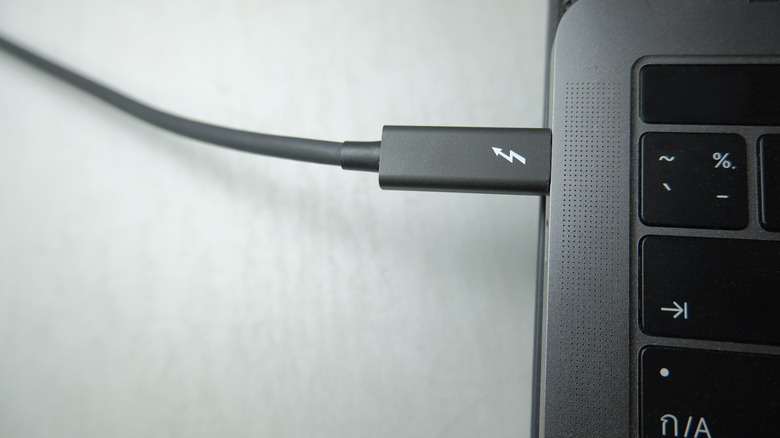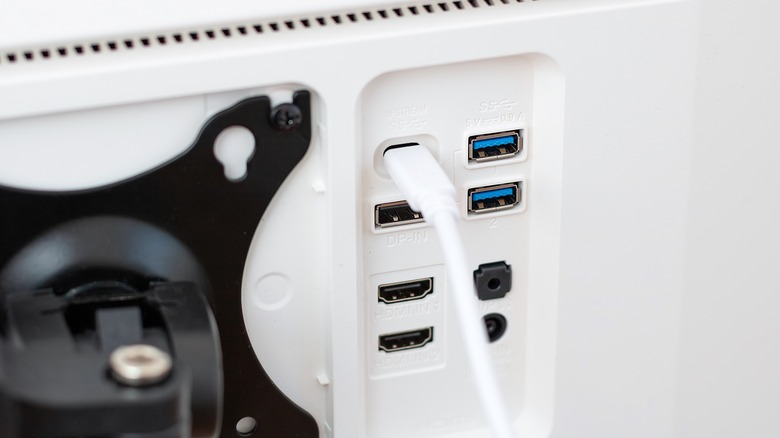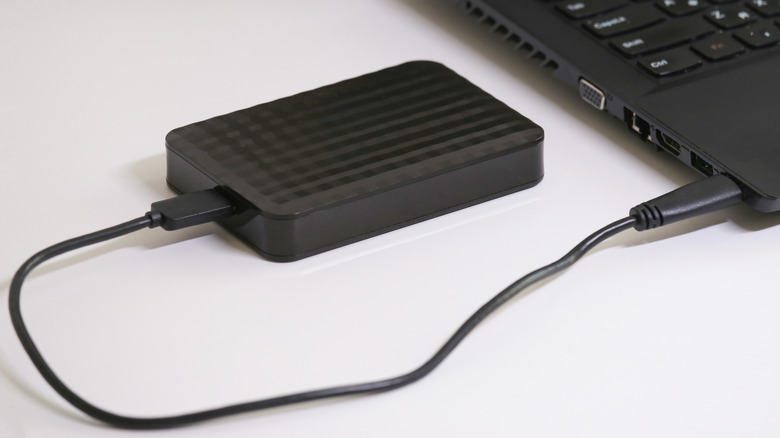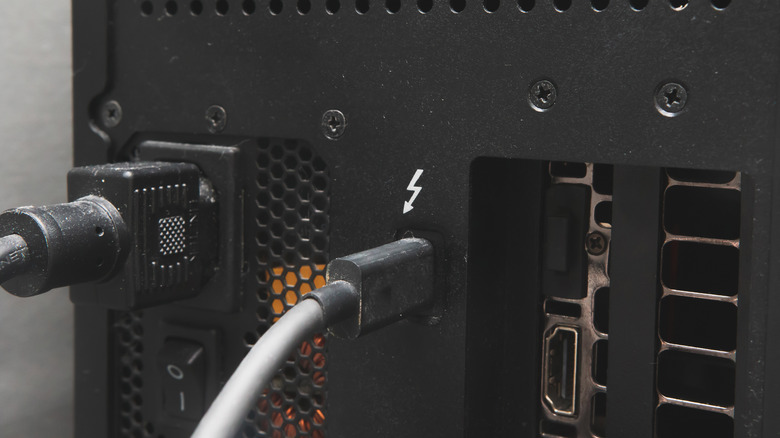5 Uses For The Thunderbolt Port On Your Your Laptop
We may receive a commission on purchases made from links.
To most people, the mention of a Thunderbolt port on your laptop may blur into meaninglessness on a long spec sheet. That's totally understandable. Thunderbolt looks identical to USB-C physically. It's often not explained very well what makes it different or why you should use it. But if you have a Thunderbolt port, there's a reason why you should care. TL;DR, Thunderbolt ports are like USB-C that started training for Mr. Universe. Many never fully appreciate just how much better Thunderbolt can be, leaving it unused. It's like having a jacuzzi in your backyard but choosing to take only a hot shower. Suffice it to say that once you really put the Thunderbolt to good use, it'll be hard to go back.
Instead of just throwing a bunch of big numbers at you and telling you that Thunderbolt's somehow better, we're going to look at practical ways you can use your Thunderbolt port. These ports are quite common, and you may not even realize you have one; they're found in competing brands like the Apple MacBook Pro and the Microsoft Surface Laptop, to name a few. Here are five uses for your laptop's Thunderbolt port beyond being just another USB-C.
Connect an external monitor without HDMI
HDMI has been the go-to display output option for decades now, and it's no slouch. The latest 2.2 specification can handle resolutions up to 12K at 120 FPS. On laptops, though, it's such a big port that manufacturers often forgo it entirely in favor of a slimmer chassis. Plus, since HDMI is a one-orientation cable, it's harder to plug it in blindly — like when reaching behind a monitor. There's nothing stopping you from getting an HDMI-to-USB-C adapter or grabbing one of the best docking stations for your laptop. However, some monitors support Thunderbolt as a display output option.
We'd argue that for a laptop-to-desktop setup where you frequently run your laptop in clamshell mode, using a Thunderbolt display is far easier and more convenient than an HDMI one. Another reason is its ability to support multiple displays from a single cable. In theory, Thunderbolt 5 allows for three 4K displays, each running at 144Hz. Laptop gamers who want high resolutions and refresh rates will be right at home with this. Plus, Thunderbolt cables can be longer (two meters) without losing data.
Alas, this does come with some caveats. The biggest? Price. The best Thunderbolt and USB-C monitors all sit deep in disposable income territory — $700 or more. It's challenging to find a Thunderbolt monitor in the budget-to-mid range. USB-C supports external displays too, and since Thunderbolt works with USB-C devices, you could easily grab a cheap Anker USB-C-to-HDMI adapter and use it with your Thunderbolt port. Or buy a USB-C monitor that doesn't command the Thunderbolt premium. Still, if you're planning on going for broke with your next monitor, then Thunderbolt input is an excellent choice.
Get faster external storage
Perhaps the biggest selling point of Thunderbolt, hands down, is its data transfer speeds. At its absolute maximum, the latest Thunderbolt 5 standard reaches Mach-speed with its 120 Gbps transfer speeds. Of course, this depends on whether your external hard drive supports the same Thunderbolt standard as your laptop. And if it does, then the price will probably reflect that. In any case, these speeds are blazing fast and will keep you from waiting around during backups or when copying over your media collection.
Aside from files being copied over much faster (which is nice), what other practical advantages does fast storage offer? The answer: a cheaper alternative to upgrading internal storage. Adding more internal storage to a laptop can be difficult or impossible, and if it's possible, it's usually expensive. Since Thunderbolt 5 has such fast data transfer speeds, you likely won't feel a huge difference between it and the SSD or NVMe slotted into your motherboard. So it ends up being a cheaper storage upgrade without a meaningful reduction in performance.
Gaming is another benefit. Gaming on external hard drives usually isn't ideal because the transfer speeds of the average external hard drive are slow. Not with Thunderbolt. In fact, the latest Thunderbolt 5 standard makes it feasible to store your games on an external SSD. This is a game changer for laptop gamers, since game file sizes continue to balloon into the hundreds of gigabytes. An external Thunderbolt drive lets you easily "upgrade" laptop storage to accommodate larger game file sizes. On top of this, you'll still get fast data transfer speeds while your Thunderbolt port powers a dock loaded with an external display and other peripherals.
Tack on an eGPU for gaming
Speaking of gaming, that's the first thing laptops often have to sacrifice. Less space means smaller graphics cards, and smaller graphics cards mean worse performance. Physics is a cruel mistress. Luckily, the tech industry has come up with a clever workaround: an eGPU for your computer. eGPUs are literally just external GPUs in a self-powered, self-cooling enclosure. They run over a cable rather than being slotted into the PCIe slot on your motherboard. The challenge is that eGPUs need lots of juice and blistering fast speeds to make your games run smoothly. Thunderbolt offers that potential.
You can see how this would be a game changer, pun intended. You can enjoy the convenience of a slim, lightweight laptop that goes anywhere, then plug it into an eGPU at home and turn it into a gaming heavyweight. It's like you get to have your cake and eat it too: an ultra-portable device when you need one, and a powerhouse that hits frame rates your laptop could never dream of.
There's one big catch, and it's that eGPUs are not cheap. Good enclosures with power and cooling for eGPUs can easily cost several hundred dollars, and then you have to buy the GPU that you're going to put inside. If you're ready to roll up your sleeves, you can even transform an unused GPU and power supply you have lying around into an eGPU for a lot cheaper. Even some Macs support eGPUs. Yes, you heard that right. However, this strangely only works on older Macs prior to the Apple Silicon transition. So if you have an Intel Mac, it may be able to run an eGPU for the handful of games macOS supports.
All displays, peripherals, internet, and power from a single cable
So far we've discussed use cases that, while great, tend to be somewhat niche. Not everyone has or needs 4K displays, external storage with professional-grade speeds, and costly eGPU setups, nor are Thunderbolt devices that support these things common. However, there's one crowd-pleaser of a feature that Thunderbolt offers: being a single cable that supplies every external device your laptop relies upon. If you have a cheap desktop dock, then you know that it can feel like your ports are a bunch of hungry siblings fighting for one box of Cheerios; there's not enough power and bandwidth for everything. Your setup necessarily gets a bit more complicated since you have to bring additional chargers and adapters into the mix. Thunderbolt solves that.
Since everything about Thunderbolt 5 is an upgrade — bandwidth, external display capabilities, power — it's capable of running multiple external displays, external hard drives, headphones, peripherals, and even juicing up extra devices from one single cable. Easily, too; speaking from personal experience, it's no fun when that cheap dock suddenly cuts one of its external displays because you plugged in your phone to charge.
Even here, though, price continues to be a compromise you'll have to make. Thunderbolt-compatible accessories have never been cheap since Intel has to rigorously certify them. A decent laptop docking station that supports Thunderbolt, like this Kensington Thunderbolt 5 docking station, will set you back a few hundred dollars at least. Depending on who you are, though, that might not be an issue. The joy of setting your laptop on your desk, plugging it in, and instantly transforming it into a capable desktop PC may well be worth the price of entry.
Run a second, removable operating system
Trying out the best Linux distros for beginners quickly takes you down a rabbit hole you might never escape from. By rabbit hole, we mean something known in the Linux community as "distro-hopping." It's when you set up and customize new Linux distros for unadulterated nerd joy, never settling on any single one for long. This introduces a small, annoying wrinkle. To properly test a Linux distro, you're going to have to dual-boot it on your computer's internal drive, which means partitioning the limited space your main OS uses. Plus, it's a pain to mess around with the boot sequence and hard drive partitions — I say this from way too much personal experience. Lots of Linux distributions let you run them almost entirely from a USB drive, but that has limitations. Using Thunderbolt, though, you could turn an external drive into a fast operating system test-run environment.
You can likely see the benefits already. Aside from having both OSes share space, you can also go into the BIOS and set the boot order to boot from the external drive first; if the external drive isn't plugged in, then it'll boot your main OS like normal. It also makes it painless and easy to wipe that operating system for a new one if you change your mind — or just wipe the drive and use it for storage. Since Thunderbolt is so fast, you could get a full-bodied Linux experience while still keeping Windows as your daily driver.
This also works on macOS. You no longer have to risk your primary macOS device when trying beta software. Instead, you just install the beta on an external drive.





